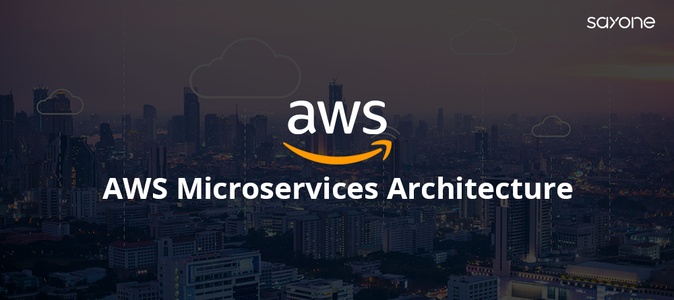How to Implement Microservices Architecture on AWS

Share This Article
Choose the best microservices vendor and trim the cost
Table of Contents
Subscribe to Our Blog
We're committed to your privacy. SayOne uses the information you provide to us to contact you about our relevant content, products, and services. check out our privacy policy.
More and more companies are going global, and businesses are digitizing on a massive scale-this is the new normal. Cloud, mobile, big data, and social technologies have had a significant impact on our daily lives.
But these digital disruptions demand change at a much faster rate. So, this new normal implies that business leaders must efficiently scale their applications and deliver existing features coherently.
And microservices are the perfect approach to achieve this.
Microservices are a software development and organizational style in which software is divided into small, self-contained services that interact via well-defined APIs. Typically, each service is owned by a small, independent team.
The cloud-computing platform AWS has building blocks that make it easy to build microservices. This article attempts to discuss the AWS microservices architecture briefly.
The Benefits of Microservices

Agility
Microservices are autonomous. That is, each service in the microservices architecture should be developed, deployed, operated, and scaled without affecting the other services in the microservice mesh.Since every team works on a different microservice, it brings agility to the entire application development process.
Flexible Scaling
Since each microservice runs independently, it can be scaled whenever required to meet customer demands. This helps in ideal resource allocation and cost-efficiency.
Simple Deployment
As microservices run as separate pieces of code, they can be updated as and when required. If any fault occurs in any one of the services, it can be rolled back and redeployed without affecting other parts of your application.
Read our latest blog "Kubernetes vs. OpenStack"
Lower Costs
Due to the atomic nature of microservices, you can allot costs to important features of your application. This substantially decreases the overall cost of your application.
Use Cases
Real-Time Data Processing
The "publish-subscribe" framework lies at the core of microservices. This architecture allows for real-time data processing, which is essential for providing instant output and insights for applications such as electronic banking, customer support systems, radar systems, and data streaming.
Big Data
When you are working with Big Data, voluminous amounts of data are to be collected, processed, and delivered at an agile rate, using data pipeline-oriented architecture. Microservices are a perfect fit for this design because each step in a data pipeline is responsible for a single small task. Microservices in big data applications include identifying credit and debit card fraud, traffic management, adaptive learning, and the analysis of food-borne illnesses.
Download Ebook for FREE "How to choose the best microservices vendor and trim the cost"
Improving Legacy Applications
Adding new functionality can be made much easier by using a microservices approach to large legacy systems. It's also helpful for changing the functioning of legacy systems. The new business functionality is implemented as one or more microservices, which are then linked to the legacy system. If you need to extend a system to support additional external partners, markets, or devices, for example, you could utilize microservices to establish co-existing new services for your existing modules while gradually modernizing the remainder of the application into a microservices design to reduce risk.
Monolithic vs Microservices Architecture
Monolithic architecture is a traditional software development approach in which all components of an application are combined into a single, self-contained unit. This approach has been around for decades, and it’s still used in some applications today. Monolithic architecture is simple, efficient, and can be deployed quickly.
Microservices architecture, on the other hand, is a modern software development approach which breaks down an application into individual, self-contained services. These services are designed to be independent, and can be deployed, managed, and scaled independently of one another. This approach allows developers to build more complex applications, and to easily update and maintain them.
Download and read the eBook "Porting from Monoliths to Microservices".
The choice between a monolithic and microservices architecture depends on the needs of the application. Monolithic architecture is simpler and can be deployed quickly, but it is not as flexible as microservices architecture. Microservices architecture is more complex and requires more expertise to implement, but it provides more flexibility and scalability.
Scaling in AWS Microservices

Scaling microservices takes a different approach than other IT solutions. When you run a monolithic application on a single server, scalability means you may add more instances and evenly distribute the load.
When you are scaling microservices, you have to manage a variety of distinct components and services. This means that either all of the components must be scaled at the same time, or you must identify which individual components must be scaled. This ensures that the different microservices can still integrate with the rest of the system.
How do you achieve the perfect scale for your application to run smoothly, without affecting the user experience? It is a three-step process: first measure performance, then maintain the performance, and allocate resources.
Our microservices experts are ready to help you! Call us today!
Of course, like with all services, it is the end-user experience that is most important, regardless of what is going on in the backend of your system. If the consumer notices a loss in speed or reliability, the solution you provided has failed in its job.
You should design a strategy for sustaining optimal performance once you have an effective monitoring system in place and a clear idea of what your performance and efficiency goals should be. And with those results, allocate the resources to maintain that optimal performance.
AWS Microservices Architecture
Because of the range of IaaS, PaaS, SaaS, and SDK packages offered by Amazon Web Services (AWS), it is one of the finest choices for launching a microservice-based application. AWS offers a diverse set of building blocks that may be used to support software of any complexity or scale.
Let’s take a look at the microservices architecture tools that AWS offers:
Compute
Amazon Elastic Container Service: For delivering microservices, containers are widely regarded as the compute platform of choice. ECS is a highly scalable, high-performance container management technology that allows Amazon Web Services customers to operate Docker containers on a managed Amazon EC2 cluster.
AWS Lambda: As an Amazon Web Services serverless offering, Lambda allows customers to upload and run application code without having to provision servers. Users simply upload their code, and Lambda takes care of the rest, including running, scaling, and maintaining high availability. Users only pay for computing when their code is actually running.
Databases
Amazon DynamoDB: This is a key-value and document database with single-digit millisecond response times. For every application, it's a fully managed, long-lasting database with built-in backup, security, and restoration, as well as in-memory cache.
Amazon S3: Scalability, data availability, security, and performance are all industry-leading features of the Amazon Simple Storage Solution. It offers simple administration capabilities that allow you to organize your data and establish fine-grained access controls to fit your specific business, organizational and compliance needs.
Read our blog "The Journey into Microservices at SoundCloud".
Amazon ElastiCache: With ElastiCache, you can boost microservice speed by allowing users to access in-memory caches that are exponentially faster than disk-based databases.
Amazon RDS: This tool simplifies the setup, management, and scaling of relational databases. Microsoft SQL, MySQL, PostgreSQL, Maria DB, and Oracle are all supported by RDS.
Amazon Aurora: Aurora is AWS's own database engine that combines the ease of use and low cost of open source databases with the performance of high-end commercial databases.
With AWS App Mesh, different microservices can communicate with each other, enabling you to easily monitor and control your microservices.
Amazon’s API Gateway enables your microservices to process thousands of API calls simultaneously.
You can also check out Amazon SNS and SQS for messaging and notifications, Cloudtrail for logging and monitoring-as we mentioned, the list doesn’t end here.
Why AWS Architecture?
AWS architecture provides a set of cloud-based services that allow you to build, deploy, and manage applications with greater speed, efficiency, and reliability. By leveraging these services, organizations can reduce their overall IT costs while increasing their agility and scalability. AWS offers a wide range of services that can be used to build, deploy, and manage applications, such as compute, storage, databases, analytics, and more. Additionally, AWS provides a secure, reliable, and cost-effective infrastructure that can be used to build, deploy, and manage applications.
Conclusion
This is just the tip of the iceberg. AWS is a gold mine of tools that facilitate improving microservices’ efficiency. You can dive deep into AWS’ ocean of solutions that deliver their best performance to empower your app with microservices.
You have now got an idea of some of the tools that the cloud computing platform uses to set up and manage microservices architecture efficiently.
Do you want to learn more about microservices architecture? Call and speak to our team today!
Share This Article
FAQs
Yes, AWS Lambda is a type of microservice. Microservices are a modern software architecture that allows developers to break down their applications into smaller, simpler, more manageable components. AWS Lambda is a serverless, event-driven computing service that allows developers to run code without the need to provision or manage servers.
No, AWS is not a microservice architecture. It is a cloud computing platform that provides a wide range of services such as computing, storage, networking, database, analytics, application services, deployment, management, mobile, developer tools, and more. It is built on an architecture that enables customers to develop and deploy applications on a global scale.
AWS Microservices Architecture offers many benefits, including faster development, improved scalability, increased agility, and lower operational costs. Additionally, it allows for better fault isolation and improved scalability, as services can scale independently of one another.
To get started with AWS Microservices Architecture, you’ll need to create an AWS account and set up the appropriate services. This includes configuring EC2 instances, setting up VPCs, creating IAM roles and policies, and setting up API Gateway. Additionally, you’ll need to have an understanding of the different services available on AWS and how to use them to build your microservices.
Subscribe to Our Blog
We're committed to your privacy. SayOne uses the information you provide to us to contact you about our relevant content, products, and services. check out our privacy policy.



